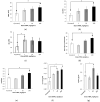Toxicological Characteristics of Bacterial Nanocellulose in an In Vivo Experiment-Part 2: Immunological Endpoints, Influence on the Intestinal Barrier and Microbiome
- PMID: 39453014
- PMCID: PMC11510458
- DOI: 10.3390/nano14201678
Toxicological Characteristics of Bacterial Nanocellulose in an In Vivo Experiment-Part 2: Immunological Endpoints, Influence on the Intestinal Barrier and Microbiome
Abstract
Bacterial nanocellulose (BNC) is considered a promising alternative to microcrystalline cellulose, as well as an ingredient in low-calorie dietary products. However, the risks of BNC when consumed with food are not well characterized. The aim of this study is to investigate the impact of BNC on immune function, the intestinal microbiome, intestinal barrier integrity, and allergic sensitization in subacute experiments on rats. Male Wistar rats received BNC with a diet for eight weeks in a dose range of 1-100 mg/kg of body weight. The measurements of serum levels of cytokines, adipokines, iFABP2, indicators of cellular immunity, composition of the intestinal microbiome, and a histological study of the ileal mucosa were performed. In a separate four-week experiment on a model of systemic anaphylaxis to food antigen, BNC at a dose of 100 mg/kg of body weight did not increase the severity of the reaction or change the response of IgG antibodies. Based on dose-response effects on immune function, the non-observed adverse effect level for BNC was less than 100 mg/kg of body weight per day. The effects of BNC on the gut microbiome and the intestinal mucosal barrier were not dose-dependent. Data on the possible presence of prebiotic effects in BNC have been obtained.
Keywords: anaphylaxis; bacterial cellulose; cytokines; intestinal barrier; intestinal microbiome; lymphocytes; nanofibers; rats; toxicity.
Conflict of interest statement
The authors declare no conflicts of interest.
Figures




References
-
- Azeredo H.M.C., Barud H., Farinas C.S., Vasconcellos V.M., Claro A.M. Bacterial cellulose as a raw material for food and food packaging applications. Front. Sustain. Food Syst. 2019;3:7. doi: 10.3389/fsufs.2019.00007. - DOI
-
- Dourado F., Leal M., Martins D., Fontao A., Rodrigues A.C., Gama M. Celluloses as food ingredients/additives: Is there room for BNC? In: Gama M., Dourado F., Bielecki S., editors. Bacterial Nanocellulose 1st Edition: From Biotechnology to Bio-Economy. Elsevier; Amsterdam, The Netherlands: 2016. pp. 123–132. Chapter 7. eISBN: 9780444634665.
Grants and funding
LinkOut - more resources
Full Text Sources

